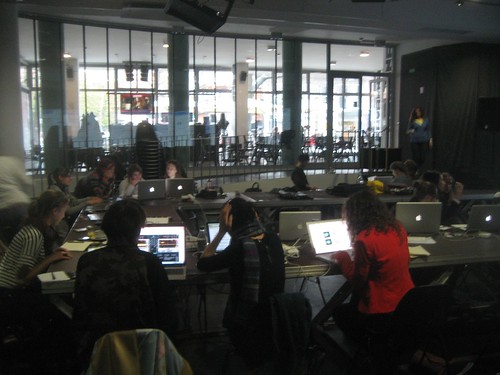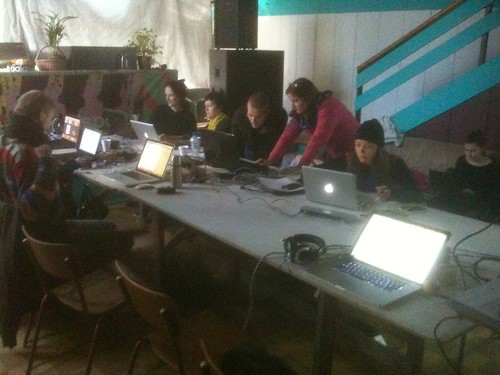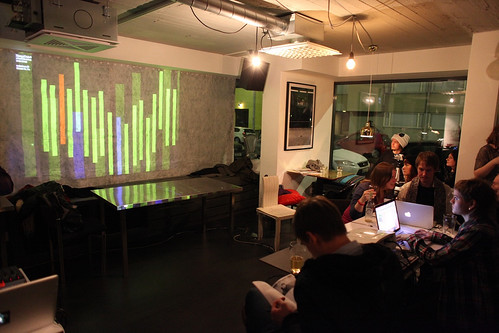On the 12th March 2016, I conducted a one-day hackathon on the topic of AVUI – Hackathon on AudioVisual User Interfaces at EAVI, Goldsmiths, University of London. The participants (eight) were challenged to create an application using the openFrameworks add-on developed by us, ofxAVUI. The four resulting projects were then integrated in the add-on repository on GitHub. These projects extended the add-on and were also illustrated by specific examples focusing on the new functionalities.
The hackathon is part of the 2-year Enabling AVUIs research project being conducted at Goldsmiths, University of London.
Category: AV
On the 25th and 26th July 2015, I conducted Gen.AV 2, a 2-day hackathon on the topic of Interactive Computer-Generated Audiovisuals at EAVI, Goldsmiths, University of London. The participants developed tools for audiovisual performance, taking into account results from a previous workshop. The results are available here: github.com/avuis/, and the projects are presented in more detail here: www.gen-av.org/gen-av-2. The hackathon is part of the 2-year Enabling AVUIs research project being conducted at Goldsmiths. Conducted in collaboration with Music Hackspace (http://musichackspace.org). The projects were presented as public performance at Goldsmiths on the 30th July 2015.
On the 6th and 7th December 2014, I conducted a 2-day hackathon on the topic of Interactive Computer-Generated Audiovisuals at EAVI, Goldsmiths, University of London. The participants developed tools for audiovisual performance, taking into account results from a previous workshop. The results are available here: github.com/avuis/. The hackathon is part of the 2-year Enabling AVUIs research project being conducted at Goldsmiths. Conducted in collaboration with Video Hackspace (http://www.videohackspace.com). There was a follow-up hackday in January, and the projects were presented as public performance at Goldsmiths on the 6th February 2015.
On 18th October 2014, I conducted a 1-day workshop on the topic of Interactive Computer-Generated Audiovisuals at EAVI, Goldsmiths, University of London. The participants designed sketches of a tool for audiovisual performance, in 2 brainstorming sessions. The workshop is part of the 2-year Enabling AVUIs research project being conducted at Goldsmiths. Conducted in collaboration with Video Hackspace (http://www.videohackspace.com).
ABOUT AVVX
AVVX (Audio Visual Vector eXchange) is a visual sequencer for VJing and audiovisual performances, using vector graphics. Based on the open image standard SVG (Scalable Vector Graphics) and JavaScript. Free, open source. Project by Nuno Correia and collaborators. To contribute visuals, send an email to: mail[at]nunocorreia.com.
Why use Scalable Vector Graphics (SVGs) for live visuals?
- SVG is an open standard
- The format is supported by most vector graphics drawing apps
- Vector graphics are very light and flexible, quick to create, and easily animated
- There is a long tradition of using simple geometric elements for visual music
- “Less is more” approach, instead of / in addition to using more powerful tools
The project “AVVX – Web Platform and Workshop” concluded with a workshop taking place 10-13 February 2014 at Aalto University’s Media Factory. Media Factory also provided the financial support for its production. Nuno Correia (Aalto University School of Arts, Design and Architecture) and Jari Kleimola (Aalto University School of Science) formed the team responsible for the project.
During the project, an entirely new version of the earlier AVVX (AudioVisual Vector eXchange) software was developed. The main additions were:
I presented two publications, Chion’s “Audio-Vision” and Ali Yuksel et al.’s “An Interface for Emotional Expression in Audio-Visuals”. I also presented my AVVX work and thesis book, and recent relevant audiovisual art works.
AVVX Visual Music workshop @ CC4AV, Riga 1-5/Oct/2013
Links
Audio-visual composition: theory, history and state of the art
- Notes on “Audio-Vision” (pdf)
- Persona opening sequence
- Audio-Visions Vimeo channel
- Audio-Visions YouTube playlist
- Interactive Audiovisual Objects book
Workshop links
I presented two publications, Chion’s “Audio-Vision” and Ali Yuksel et al.’s “An Interface for Emotional Expression in Audio-Visuals”. I also presented my AVVX work and thesis book, and recent relevant audiovisual art works. I proposed an assignment, and gave advice on the final projects. I also gave advice on the workshop structure, and took care of video documentation.
Links
- Audio-Visions Vimeo channel
- Interactive Audiovisual Objects book
- Notes on “Audio-Vision” (pdf)
- Notes on “An Interface for Emotional Expression in Audio-Visuals” (pdf)
Audio-visualization of emotions – short assignment
Prepare a short video (around 30s-1m) audio-visualising two of the basic emotions identified by Dr. Paul Ekman (ideally a transition of one to the other), as presented by Sasa Kerkos.
The video should use as its starting point the previous assignment by Sasa Kerkos (emotion visualisation). Take care in combining audio and image, and aim to create added value as defined by Michel Chion.
The video and its sound can be made with original material or reusing material by others. Link to free media resources on the web: http://commons.wikimedia.org/wiki/Commons:Free_media_resources
The 2 day “AVVX – Visual Music with Vector Graphics” workshop took place at Aalto FabLab, Helsinki, as part of the CCLV – Creative Coding for Live Visuals event – organised by PixelAche/AAVE Festival, 10-11 April 2013. During the workshop, we discussed visual music; participants were introduced to the AVVX app; and prepared visuals for the software.
As per suggestion of the organisers, the sound source for the visualisations would come from one single musician/group. I proposed music by my project Baltic Diving Co (SoundCloud link), with Joel Tammik.
On the 3rd day, 13/April, we had a final performance at Sandro Bar, Helsinki.
AVVX app (free, open source) available at www.avvx.org.
Thank you to course participants, AAVE and PixelAche (in particular Irina Spicaka).



